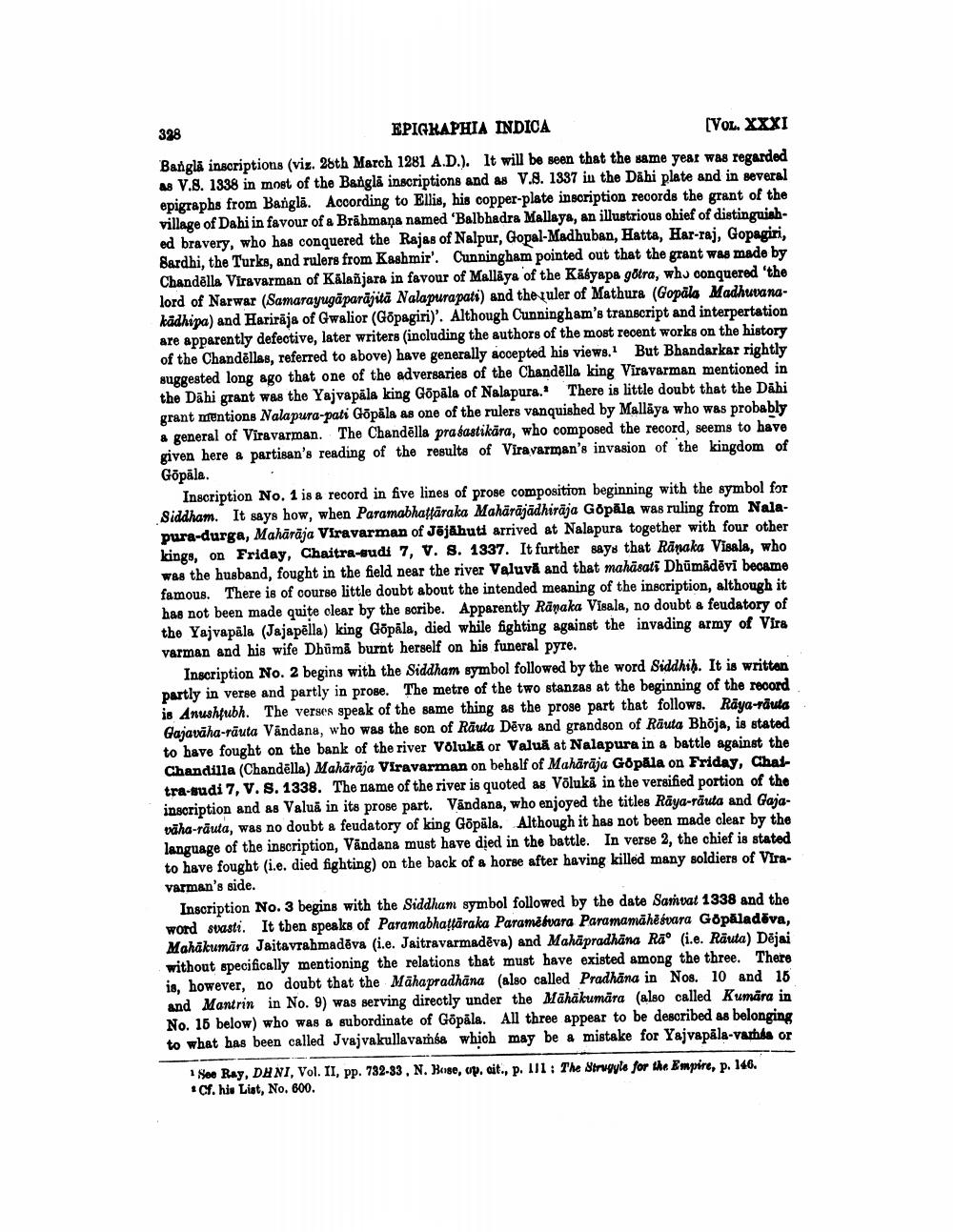________________
338 EPIGRAPHIA INDICA
[VOL. XXXI Bangla inscriptions (viz. 28th March 1281 A.D.). It will be seen that the same year was regarded as V.8. 1938 in most of the Bangla inscriptions and as V.8. 1337 in the Dāhi plate and in several epigraphs from Bangla. According to Ellis, his copper-plate inscription records the grant of the village of Dahi in favour of a Brāhmaṇa named 'Balbhadra Mallaya, an illustrious ohief of distinguished bravery, who has conquered the Rajas of Nalpur, Gopal-Madhuban, Hatta, Har-raj, Gopagiri, Bardhi, the Turks, and rulers from Kashmir'. Cunningham pointed out that the grant was made by Chandēlla Viravarman of Kälañjara in favour of Mallaya of the Kábyapa gotra, who conquered the lord of Narwar (Samarayugāparājitā Nalapurapati) and the ruler of Mathura (Gopala Madhuvanakadhipa) and Hariraja of Gwalior (Gopagiri)'. Although Cunningham's transcript and interpertation are apparently defective, later writers (including the authors of the most recent works on the history of the Chanděllas, referred to above) have generally accepted his views. But Bhandarkar rightly suggested long ago that one of the adversaries of the Chandēlla king Viravarman mentioned in the Dāhi grant was the Yajvapāla king Gõpāla of Nalapura. There is little doubt that the Dähi grant mentions Nalapura-pati Gõpāla as one of the rulers vanquished by Mallāya who was probably & general of Viravarman. The Chandēlla prasastikāra, who composed the record, seems to have given here & partisan's reading of the results of Viravarman's invasion of the kingdom of Gopāla.
Inscription No. 1 is a record in five lines of prose composition beginning with the symbol for Siddham. It says how, when Paramabhatfāraka Mahärājādhiraja Gopāla was ruling from Nalapura-durga, Mahārāja Viravarman of Jējahuti arrived at Nalapura together with four other kings, on Friday, Chaitra-eudi 7, V. S. 1337. It further says that Ränaka Visala, who was the husband, fought in the field near the river Valuvā and that mahäsati Dhūmadēvi became famous. There is of course little doubt about the intended meaning of the inscription, although it has not been made quite clear by the boribe. Apparently Ränaka Visala, no doubt a feudatory of the Yajvapāla (Jajapēlla) king Gopāla, died while fighting against the invading army of Vira varman and his wife Dhūmă burnt herself on his funeral pyre.
Inscription No. 2 begins with the Siddham symbol followed by the word Siddhih. It is writtan partly in verse and partly in prose. The metre of the two stanzas at the beginning of the record is Anushfubh. The verses speak of the same thing as the proge part that follows. Rāya-rauta Gajaväha-räuta Vandana, who was the son of Rauta Dēva and grandson of Räuta Bhöja, is stated to have fought on the bank of the river Völukā or Valuă at Nalapura in a battle against the Chandilla (Chandella) Mahärāja Viravarman on behalf of Mahārāja Gopala on Friday, Chattra-sudi 7, V. S. 1338. The name of the river is quoted as Võluka in the versified portion of the inscription and as Valuã in its prose part. Vandana, who enjoyed the titles Rāya-rāuta and Gajaväha-rāuta, was no doubt a feudatory of king Gopāla. Although it has not been made clear by the language of the inscription, Vändana must have died in the battle. In verse 2, the chief is stated to have fought (i.e. died fighting) on the back of a horse after having killed many soldiers of Viravarmen's side.
Inscription No. 3 begins with the Siddham symbol followed by the date Samvat 1338 and the word svasti. It then speaks of Paramabhatfaraka Paramétvara Paramamāhēsvara Gopāladova, Mahākumāra Jaitavrahmadēva (i.e. Jaitravarmadēva) and Mahapradhana Rao (i.e. Rauta) Dējai without specifically mentioning the relations that must have existed among the three. There is, however, no doubt that the Mahapradhana (also called Pradhana in Nos. 10 and 16 and Mantrin in No. 9) was serving directly under the Mähälumära (also called Kumära in No. 16 below) who was a subordinate of Gopāla. All three appear to be described as belonging to what has been called Jvajvakullavamsa which may be a mistake for Yajvapāla-varba or
1 See Ray, DANI, Vol. II, pp. 732-33, N. Bose, op. cit., p. III: The Strugyle for the Empire, p. 146. CY. his List, No. 600.




